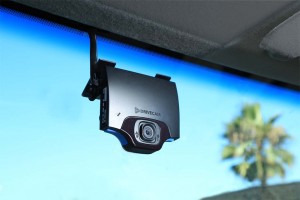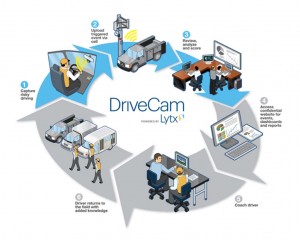
The Lytx DriveCam system and others like it will help save hundreds of lives by giving heavy truck drivers one more tool to avoid accidents.
As costs plunge, video cameras are becoming more the norm than the exception in vehicles, and federal regulators going so far as to mandate that all passenger cars and light trucks must be equipped with backup cameras by 2018, a move expected to save hundreds of lives annually.
A new study suggests that video technology could have an equally dramatic impact on the heavy-truck side of the highway. A report by the Virginia Tech Transportation Institute estimates the Lytx DriveCam system could reduce the number of fatal bus and truck crashes by at least 20%, saving more than 800 lives a year.
But whether the DriveCam will be accepted by drivers remains to be seen as it could be seen as little more than a high-tech tattletale.

The Lytx DriveCam system allows driver behavior to be monitored so that heavy-truck and bus drivers can become safer drivers.
At its most basic, the Lytx DriveCam Program is designed to serve as “a closed-loop behavior modification system,” according to the authors of the Virginia Tech study. That’s a fancy way of saying that it is designed to monitor driver behavior behind the wheel, using both video and kinematic data. It’s automatically triggered by risky behaviors, such as swerving between lanes, with the data being wirelessly transmitted to a Lytx review center.
“Trained analysts review the video and kinematic data and record what the driver was doing during the captured events, then a severity score for each video event is calculated,” according to the study. Supervisors then meet with drivers to “coach” them “on how to avoid future risky behaviors. Lastly, the drivers return to the field with added knowledge and motivation to drive safely.”
Using both federal crash data and a field study of the Lytx Program, the researchers estimated about 727 fatal bus and truck crashes, or 20% of those that occur in the U.S. each year, could be prevented, saving 801 lives. The reduction in terms of injury accidents is predicted to be an even more significant 35%, preventing 39,066 injuries annually.
The study also suggested the DriveCam technology could prove effective if used in passenger vehicles. An earlier project found that when used to help coach novice teen drivers, the system reduced the number of “risky driving events” they committed during the two months after training by 58% — from 8.6 “events” per 1,000 miles to just 3.6.
At first glance, the DriveCam system might seem to be a variant of the so-called “black box” data recorders that the National Highway Traffic Safety Administration wants to be placed in widespread highway use. But the authors of the study note some significant differences. Critically, a black box simply provides a record of what happened after a crash occurs, and is not actually used to address potentially risky behavior in a way that could prevent future accidents.
There is a potential problem with the technology. It could prove difficult to get drivers to accept the idea that their every move behind the wheel is being monitored and could bring disciplinary action, perhaps even a dismissal. But corporate fleets have increasingly started to monitor drivers to prevent risky behavior and the possibility of vehicle or cargo theft.
(Fiat Chrysler redefining image as it lays out strategy. For more, Click Here.)
On the flip side, a system like DriveCam could be used as evidence against a fleet owner who did not properly supervise a wayward driver.
But such technology appears to be gaining ground in one form or another. Mercedes-Benz and Lexus are among the manufacturers who have introduced monitoring systems into their vehicles that can sense when a driver is tired and risks falling asleep behind the wheel.
(Click Here for TDB’s first drive in the Mercedes B-Class EV.)
Meanwhile, a growing number of insurance companies, including Allstate and Progressive, now offer policies that require a motorist to install a telematics-based monitoring system into their vehicle. Those who practice safe driving guidelines can qualify for reduced premiums.
(To see how fuel prices impacted what vehicles Americans are buying, Click Here.)
A study released last month by the Deliotte Center for Financial Services found that 53% of American drivers would accept that trade-off, including nearly two-thirds of those between the ages of 21 and 29.

The 20% of total truck fatalities seems a bit ambitious when one considers that 65-75% of all fatal truck crashes are attributed to factors other than the truck driver.
More likely, it’s 20% of the fatal truck crashes in which the truck driver is found to be at fault. That works out to about 6% of total truck related fatalities. Still a significant number (about 300/year), but not as good of a sales pitch.
What will sell (and already is selling) devices like this is the fact that the video will prove the truck driver innocent in a crash about three times as often as it proves guilt.
http://www.usatoday.com/story/news/nation/2014/05/08/bus-truck-video-monitors-could-save-lives/8815185/
This piece clarifies the 20% stat as relating to the portion of accidents where the truck driver was found at fault, but then quotes the same erroneous total number where it appears that the 20% reduction figure is applied to all truck involved fatalities regardless of fault.